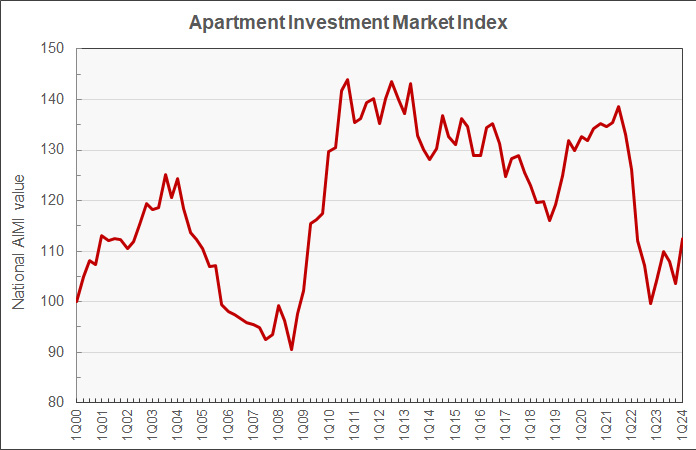Freddie Mac recently released its Apartment Market Investment Index (AIMI) for Q1 2024. The national index was up 8.8 percent in the quarter, indicating improving conditions for multifamily property investment. The improvement was largely due to a fall in mortgage interest rates. Freddie Mac reported that mortgage rates declined from 6.49 percent to 5.93 percent in the quarter.
Assessing the trends
For those unfamiliar with Freddie Mac’s AIMI, please see “Defining AIMI” below.
Note that a fall in property values leads to a higher AIMI. So, while a higher AIMI is a signal that it a better time to make a new investment in multifamily property, it does not necessarily mean that conditions are better for current multifamily property owners. However, falling interest rates and rising rental income will also result in a higher AIMI and these are good for both owners and buyers of multifamily property.
The national AIMI since 1Q 2000 is shown in the first chart, below.

The chart shows the AIMI has improved since hitting a recent low in Q4 2022. Looking at AIMI’s constituent parts, the rental income index has been largely flat since Q2 2022, varying only +/- 1.2 percent from its average value over that time. The property value index has been falling, also since Q2 2022, with a total decline of 17 percent. However, interest rates have been rising since Q3 2021 and more than doubled between then and the high they reached in Q4 2023. It is the rise in interest rates that accounts for the fall in the AIMI seen since Q3 2021.
Who’s rising now
The following table shows the quarterly, annual and 5-year percentage changes for the AIMI in the cities tracked by Freddie Mac.
| Location | 1 Quarter AIMI change (percent) | 1 Year AIMI change (percent) | 5 Year AIMI change (percent) |
| New York | 5.2 | 6.6 | 25.2 |
| Dallas | 5.7 | (0.2) | (17.7) |
| Tampa | 6.3 | 5.6 | (15.3) |
| Los Angeles | 6.8 | 4.0 | 1.4 |
| Philadelphia | 7.4 | 10.1 | 12.2 |
| Portland | 7.4 | 1.2 | (6.5) |
| Nashville | 7.6 | 0.7 | (20.3) |
| Chicago | 7.7 | 2.9 | 5.8 |
| Houston | 7.7 | 12.1 | (0.4) |
| Oakland | 7.7 | 9.1 | (3.9) |
| Atlanta | 7.8 | 4.1 | (17.5) |
| Minneapolis | 7.9 | 8.6 | (7.1) |
| Miami | 8.0 | 0.5 | (5.3) |
| Charlotte | 8.0 | 3.5 | (15.4) |
| San Diego | 8.3 | 2.3 | (4.9) |
| Las Vegas | 8.3 | 5.6 | (21.9) |
| Boston | 8.4 | 9.6 | (7.9) |
| Raleigh | 8.6 | 17.5 | (10.7) |
| National | 8.7 | 8.1 | (5.7) |
| District of Columbia | 8.8 | 10.7 | (7.9) |
| Orlando | 8.9 | 4.3 | (13.0) |
| Jacksonville | 9.0 | 5.6 | (17.6) |
| Phoenix | 9.2 | 7.9 | (26.2) |
| Denver | 9.6 | 17.5 | (7.8) |
| Seattle | 10.3 | 14.2 | 4.0 |
| San Francisco | 10.4 | 10.8 | (8.8) |
The rental income component of the AIMI fell 7.5 percent year-over-year nationally. Rental income declined in all 25 metros tracked by Freddie Mac. Metros with the smallest rental income declines since Q1 2023 included Chicago (-0.25 percent), Miami (-1.42 percent), Dallas (-2.80 percent) and New York (-3.96 percent). Metros with the greatest rental income declines since Q1 2023 included Raleigh (-15.20 percent), Denver (-13.44 percent), Seattle (-10.81 percent) and Phoenix (-9.71 percent).
The property value component of the AIMI fell 0.77 percent year-over-year nationally. Property values rose in 8 of the 25 metros tracked by Freddie Mac. Metros with the greatest increases in property values since Q1 2023 included Chicago (2.22 percent), Washington D.C. (2.18 percent), San Francisco (1.44 percent) and Boston (1.19 percent). Metros with the greatest decline in property values since Q1 2023 included Jacksonville (-5.31 percent), Atlanta (-5.26 percent), Orlando (-5.22 percent) and Charlotte (-3.99 percent).
Defining AIMI
Freddie Mac developed the AIMI as a quick way to assess the changing attractiveness of investing in multifamily property in a given market over time. It is derived from three market variables: the interest rate on multifamily mortgages, the growth rate in multifamily property prices and the growth rate in multifamily net operating income (NOI). The higher the value of the AIMI, the more attractive an investment in multifamily property is said to be. Higher growth in NOI results in a higher AIMI while higher multifamily mortgage interest rates or higher growth rates in multifamily property prices result in a lower AIMI.
Each quarter, Freddie Mac calculates a national AIMI and also local AIMI’s for 25 top metro areas. Since the AIMI for each metro area is normalized to a value of 100 for Q1 2000, the absolute value of the AIMI for the different metros cannot be used as a measure of the comparative attractiveness of investments in multifamily property between the metros. This is because the market conditions in each of the metros in Q1 2000 were different, so each metro’s AIMI is calculated relative to a different baseline. However, the changes in the levels of the AIMI for any given metro are an indication of whether investment conditions are improving in that metro.



